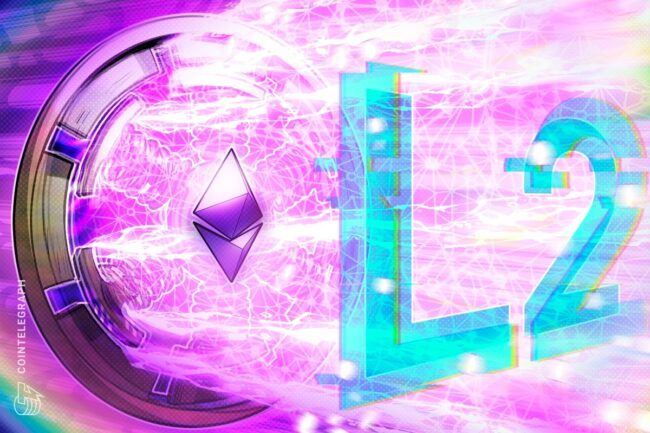Layer 2s have been a great blockchain success story. They’ve reduced congestion on the Ethereum mainnet, driving down gas fees while preserving security.
But maybe they’ve become too successful, drawing chain activity and fee income from the parent that spawned them? At least that’s what some are suggesting lately, most recently at Cornell Tech’s blockchain conference in late April.
Indeed, some think Ethereum should be a little greedier, or at least fight harder for a bigger part of the revenue pie, particularly sequencing fees.
“People in the Ethereum Foundation [the nonprofit that supports the Ethereum ecosystem] will tell you that, ‘Yes, we effed up by being too ivory tower.’ I have heard that multiple times,” said David Hoffman, an owner at Bankless, during a panel discussion at the Cornell Tech event in New York City on April 25.
Elsewhere, Hoffman has urged Ethereum to make a “strategic pivot,” noting that the crypto environment has changed in the last few years. Ethereum no longer has the “luxury of being a peace-time research project…. exploited by its competition.”
L2s are reaping millions of dollars in transaction order fees (sometimes called sequencing fees), but none of these revenues are being passed on to Ethereum, according to James Beck, head of growth at ENS Labs and another speaker at the New York City conference. Beck told Cointelegraph:
So, this cultural layer of podcasters and researchers are saying, ‘Well, the price of ETH has been dropping compared to these other tokens. What do we do to make Ethereum more powerful?’
In short, Ethereum is a neutral verification layer, but the Ethereum mainnet is not being fairly compensated for the work that it is doing. Centralized for-profit L2s like Base, Optimism and Arbitrum are gathering the lucrative sequencing fees while enjoying the security and liveness guarantees of the Ethereum mainnet at relatively little economic cost.
L2s soared after Dencun upgrade
L2 rollups are a recent innovation; they only emerged in 2023. The idea was to reduce chain congestion and gas fees by moving transaction processing from the main blockchain (layer 1) to separate chains that sit atop the mainnet (L2s). But transaction processing is arguably the most profitable part of the revenue game, especially when users opt to pay priority fees to get their orders processed faster.
Fee-sharing was rarely much of an issue before Ethereum’s March 2024 Dencun upgrade, which introduced blob transactions to help scale layer 2s. Blobs significantly reduced the cost for L2s to post data to Ethereum, allowing them to operate more profitably, CoinMetrics researcher analyst Tanay Ved told Cointelegraph this week.
Since then, L2 user demand has soared, especially on Base, the L2 launched by Coinbase in August 2023 on the Ethereum mainnet.
As Ved noted in an April 8 blog, Base has earned a total of ~$98 million in revenues from user-transaction fees (including base and priority fees), “while paying only ~$4.9M to the Ethereum base layer, resulting in a total estimated profit of $94M since the Dencun upgrade.”
Ved added:
This dynamic has led to many questioning whether Layer-2s are net positive for Ethereum, or whether they are ‘extractive.
Base’s response
Asked about fees, a Base spokesperson told Cointelegraph, “Today, Base already pays Ethereum fees for every transaction on Base. All transactions are settled on Ethereum, and so far, Base has paid Ethereum more than $20 million in settlement fees since Base’s inception.” One can see these fees on Token Terminal under “cost of revenue,” the spokesperson added.
“Overall, Base makes getting onchain more accessible with fast and cheap transactions and helps grow the Ethereum ecosystem by onboarding more users, builders, apps and assets, all of whom are transacting in ETH and driving demand,” said the spokesperson.
Related: Institutions break up with Ethereum but keep ETH on the hook
However, in many, if not most months, Base’s overall fees are roughly 10 times the amount paid to Ethereum for settling trades, according to examination of the referenced Base financial statement. In April, for instance, the most recent full month, Base reaped $3.7 million in fees, but only $305,000 was delivered to Ethereum as settlement fees — about 8% of total fees.
Still, maybe things aren’t quite so dire. Even if fees are out of kilter now, the imbalance may not last, others caution. Ethereum hard forks like Pectra, which went live yesterday (May 7), and Fusaka, scheduled for late 2025, will increase blob throughput. “This means L2s will be able to post more blobs, potentially driving higher total blob fees to mainnet,” Ved told Cointelegraph.
Ethereum is already consistently hitting the current blob target of three per block, as the chart below shows. “Pectra will raise this to six blobs per block — with a…
cointelegraph.com
